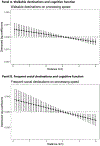Spatial scale effects on associations between built environment and cognitive function: Multi-Ethnic Study of Atherosclerosis
- PMID: 38340497
- PMCID: PMC11748873
- DOI: 10.1016/j.healthplace.2024.103181
Spatial scale effects on associations between built environment and cognitive function: Multi-Ethnic Study of Atherosclerosis
Abstract
Built environments have the potential to favorably support cognitive function. Despite growing work on this topic, most of the work has ignored variation in the spatial scale of the effect. The issue with spatial scale effects is that the size and shape of the areal unit within which built environment characteristics are measured naturally influence the built environment exposure metric and thus the estimated associations with health. We used spatial distributed lag modeling (DLM) to estimate how associations between built environment exposures (walkable destinations [WD], social destinations [SD]) and change in cognition varied across distance of these destinations from participants' residences. Cognition was assessed as maintained/improved processing speed (PS) and global cognition (GC). Person-level data from Exam 5 (2010-2012) and Exam 6 (2016-2018) of the Multi-Ethnic Study of Atherosclerosis was used (N = 1380, mean age 67). Built environment data were derived from the National Establishment Time Series. Higher availability of walkable and social destinations at closer distance from participants' residence was associated with maintained/improved PS. The adjusted associations between maintained/improved PS and destinations waned with increasing distance from the residence; associations were evident until approximately 1.9-km for WD and 1.5-km for SD. Associations were most apparent for participants living in areas with high population density. We found little evidence for associations between change in GC and built environment at any distance. These results highlight the importance of identifying appropriate spatial scale to understand the mechanisms for built environment-cognition associations.
Keywords: Built environment; Cognitive function; Distributed lag modeling; Healthy aging; Spatial scale effects.
Copyright © 2024 Elsevier Ltd. All rights reserved.
Figures

Similar articles
-
Exploring the spatial scale effects of built environments on transport walking: Multi-Ethnic Study of Atherosclerosis.Health Place. 2022 Jan;73:102722. doi: 10.1016/j.healthplace.2021.102722. Epub 2021 Dec 3. Health Place. 2022. PMID: 34864555 Free PMC article.
-
Longitudinal Associations between the Neighborhood Built Environment and Cognition in US Older Adults: The Multi-Ethnic Study of Atherosclerosis.Int J Environ Res Public Health. 2021 Jul 28;18(15):7973. doi: 10.3390/ijerph18157973. Int J Environ Res Public Health. 2021. PMID: 34360264 Free PMC article.
-
Comparing effects of Euclidean buffers and network buffers on associations between built environment and transport walking: the Multi-Ethnic Study of Atherosclerosis.Int J Health Geogr. 2022 Sep 17;21(1):12. doi: 10.1186/s12942-022-00310-7. Int J Health Geogr. 2022. PMID: 36115992 Free PMC article.
-
An Overview of How the Built Environment Relates to Children's Health.Curr Environ Health Rep. 2023 Sep;10(3):264-277. doi: 10.1007/s40572-023-00405-8. Epub 2023 Jul 28. Curr Environ Health Rep. 2023. PMID: 37507592 Review.
-
The association between built environment features and physical activity in the Australian context: a synthesis of the literature.BMC Public Health. 2016 Jun 8;16:484. doi: 10.1186/s12889-016-3154-2. BMC Public Health. 2016. PMID: 27277114 Free PMC article. Review.
References
-
- Allman RM, Sawyer P, & Roseman JM (2006). The UAB Study of Aging: background and insights into life-space mobility among older Americans in rural and urban settings. Aging Health 2(3), 417–429.
-
- Almon S, 1965. The distributed lag between capital appropriations and expenditures. Econometrica: Journal of the Econometric Society 33 (1), 178–196. 10.2307/1911894. - DOI
-
- Bae JB, Kim YJ, Han JW, Kim TH, Park JH, Lee SB, … & Kim KW (2015). Incidence of and risk factors for Alzheimer’s disease and mild cognitive impairment in Korean elderly. Dementia and geriatric cognitive disorders, 39(1–2), 105–115. - PubMed
-
- Baek J, Hirsch JA, Moore K, Tabb LP, Barrientos-Gutierrez T, Lisabeth LD, Diez-Roux AV, Sanchez BN, 2017. Statistical methods to study variation in associations between food store availability and body mass in the multi-ethnic study of atherosclerosis. Epidemiology 28 (3), 403–411. 10.1097/EDE.0000000000000631. - DOI - PMC - PubMed
MeSH terms
Grants and funding
- 75N92020D00001/HL/NHLBI NIH HHS/United States
- R01 HL131610/HL/NHLBI NIH HHS/United States
- R01 AG058969/AG/NIA NIH HHS/United States
- HHSN268201500003I/HL/NHLBI NIH HHS/United States
- N01 HC095166/HL/NHLBI NIH HHS/United States
- N01 HC095160/HL/NHLBI NIH HHS/United States
- 75N92020D00002/HL/NHLBI NIH HHS/United States
- HHSN268201500003C/HL/NHLBI NIH HHS/United States
- N01 HC095161/HL/NHLBI NIH HHS/United States
- 75N92020D00005/HL/NHLBI NIH HHS/United States
- N01 HC095168/HL/NHLBI NIH HHS/United States
- R01 HL071759/HL/NHLBI NIH HHS/United States
- UL1 TR001079/TR/NCATS NIH HHS/United States
- N01 HC095169/HL/NHLBI NIH HHS/United States
- R01 AG072634/AG/NIA NIH HHS/United States
- N01 HC095167/HL/NHLBI NIH HHS/United States
- N01 HC095159/HL/NHLBI NIH HHS/United States
- 75N92020D00003/HL/NHLBI NIH HHS/United States
- UL1 TR001420/TR/NCATS NIH HHS/United States
- 75N92020D00004/HL/NHLBI NIH HHS/United States
- N01 HC095163/HL/NHLBI NIH HHS/United States
- 75N92020D00007/HL/NHLBI NIH HHS/United States
- R01 AG049970/AG/NIA NIH HHS/United States
- R01 AA028552/AA/NIAAA NIH HHS/United States
- R01 HL148431/HL/NHLBI NIH HHS/United States
- UL1 TR000040/TR/NCATS NIH HHS/United States
- N01 HC095162/HL/NHLBI NIH HHS/United States
- 75N92020D00006/HL/NHLBI NIH HHS/United States
- N01 HC095165/HL/NHLBI NIH HHS/United States
- N01 HC095164/HL/NHLBI NIH HHS/United States
LinkOut - more resources
Full Text Sources
Medical
Miscellaneous

